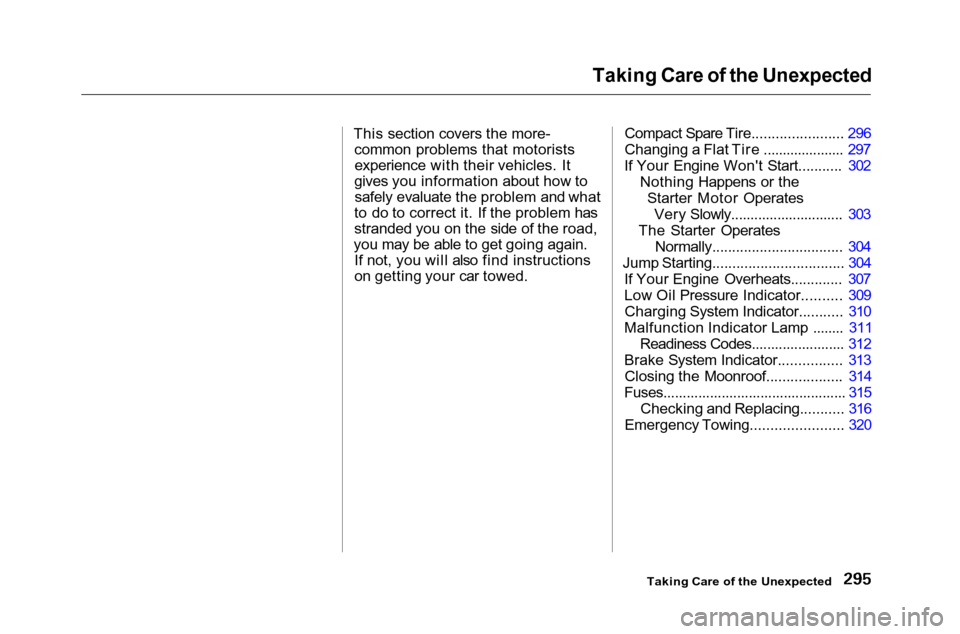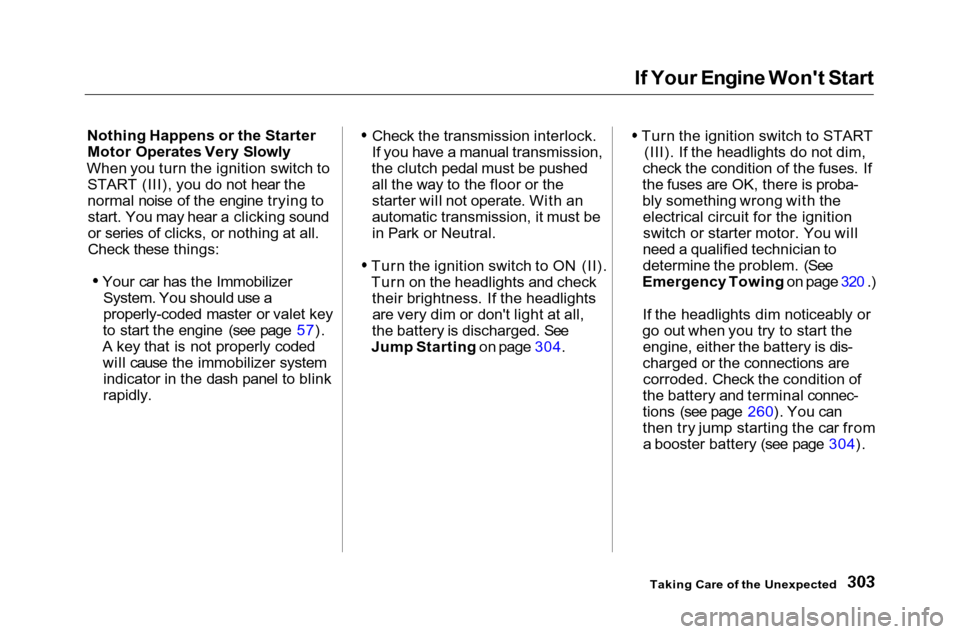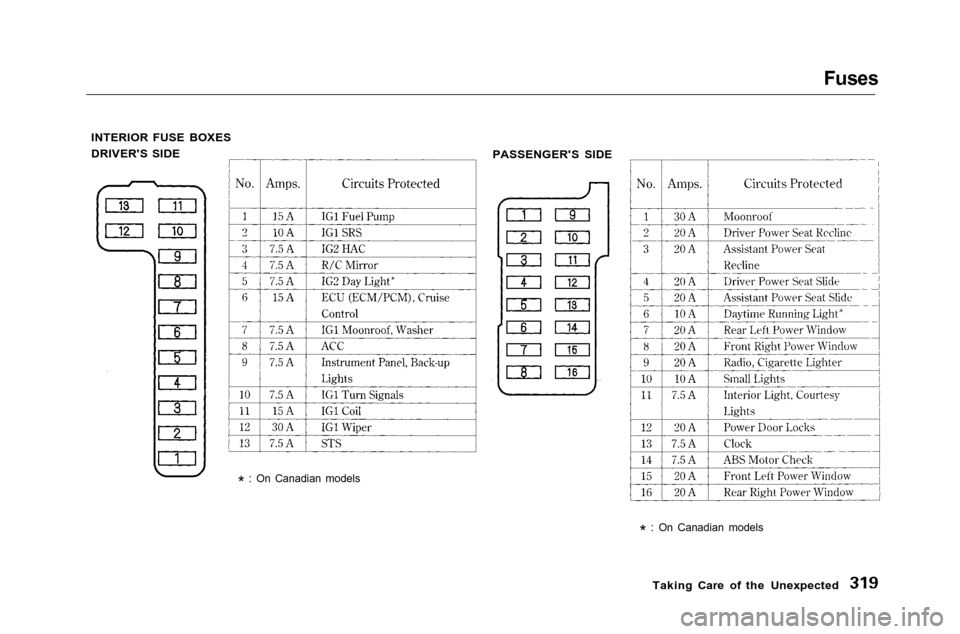fuses HONDA ACCORD COUPE 2001 CF / 6.G Owners Manual
[x] Cancel search | Manufacturer: HONDA, Model Year: 2001, Model line: ACCORD COUPE, Model: HONDA ACCORD COUPE 2001 CF / 6.GPages: 372, PDF Size: 6.1 MB
Page 298 of 372

Taking Care of the Unexpected
This section covers the more- common problems that motoristsexperience with their vehicles. It
gives you information about how to safely evaluate the problem and what
to do to correct it. If the problem has
stranded you on the side of the road,
you may be able to get going again. If not, you will also find instructions
on getting your car towed. Compact Spare Tire....................... 296
Changing a Flat Tire ..................... 297
If Your Engine Won't Start........... 302 Nothing Happens or theStarter Motor OperatesVery Slowly............................. 303
The Starter Operates Normally................................. 304
Jump Starting................................. 304 If Your Engine Overheats............. 307
Low Oil Pressure Indicator.......... 309Charging System Indicator........... 310
Malfunction Indicator Lamp ........ 311 Readiness Codes........................ 312
Brake System Indicator................ 313 Closing the Moonroof................... 314
Fuses............................................... 315 Checking and Replacing........... 316
Emergency Towing....................... 320
Taking Care of the Unexpected
Page 306 of 372

If Your Engine Won't Start
Nothing Happens or the Starter Motor Operates Very Slowly
When you turn the ignition switch to START (III), you do not hear the
normal noise of the engine trying tostart. You may hear a clicking sound
or series of clicks, or nothing at all.
Check these things:
Your car has the ImmobilizerSystem. You should use a
properly-coded master or valet key
to start the engine (see page 57).
A key that is not properly coded will cause the immobilizer systemindicator in the dash panel to blink
rapidly. Check the transmission interlock.
If you have a manual transmission,
the clutch pedal must be pushed all the way to the floor or the
starter will not operate. With an
automatic transmission, it must be
in Park or Neutral.
Turn the ignition switch to ON (II).
Turn on the headlights and check their brightness. If the headlightsare very dim or don't light at all,
the battery is discharged. See
Jump Starting on page 304. Turn the ignition switch to START
(III). If the headlights do not dim,
check the condition of the fuses. If
the fuses are OK, there is proba-
bly something wrong with the electrical circuit for the ignitionswitch or starter motor. You will
need a qualified technician to
determine the problem. (See
Emergency Towing on page 320 .)
If the headlights dim noticeably or
go out when you try to start the engine, either the battery is dis-
charged or the connections arecorroded. Check the condition of
the battery and terminal connec-
tions (see page 260). You can
then try jump starting the car from a booster battery (see page 304).
Taking Care of the Unexpected
Page 307 of 372

If Your Engine Won't Start, Jump Starting
The Starter Operates Normally In this case, the starter motor's
speed sounds normal, or even faster
than normal, when you turn the
ignition switch to START (III), but
the engine does not run.
Are you using the proper startingprocedure? Refer to Starting the
Engine on page 193 .Do you have fuel? Turn the
ignition switch to ON (II) for a
minute and watch the fuel gauge.
The low fuel level warning light may not be working, so you werenot reminded to fill the tank.
There may be an electrical problem, such as no power to the
fuel pump. Check all the fuses (see page 315).
If you find nothing wrong, you will
need a qualified technician to find
the problem. See Emergency
Towing on page 320 . Jump Starting
If your car's battery has run down,
you may be able to start the engine
by using a booster battery. Although
this seems like a simple procedure,
you should take several precautions.
You cannot start a Honda with an automatic transmission by pushing
or pulling it. To jump start your car, follow these
directions closely:
1. Open the hood and check the physical condition of the battery(see page 260). In very cold
weather, check the condition of the electrolyte. If it seems slushy
or like ice, do not try jump starting
until it thaws.
If a battery sits in extreme cold, the electrolyte inside can freeze.
Attempting to jump start with a frozen battery can cause it to rupture.
2. Turn off all the electrical acces- sories: climate control, stereo
system, lights, etc.
Put the transmission in Neutral or
Park and set the parking brake.
Taking Care of the Unexpected
A battery can explode if you do
not follow the correct procedure,
seriously injuring anyone nearby.
Keep all sparks, open flames,
and smoking materials away
from the battery.
NOTICE
Page 318 of 372

Fuses
All the electrical circuits in your car have fuses to protect them from ashort circuit or overload. These
fuses are located in three fuse boxes.
The interior fuse boxes are locatedon each side of the dashboard. To
open an interior fuse box, open thecar door. Pull the cover open, then
take it out of its hinges by pulling it toward you.
UNDER-HOOD
TAB
The under-hood fuse box is located in the back of the engine compart-
ment on the passenger's side. Toopen it, push the tabs as shown.
Taking Care of the Unexpected
INTERIOR
Page 319 of 372

Fuses
Checking and Replacing Fuses
If something electrical in your carstops working, the first thing you
should check for is a blown fuse.
Determine from the chart on pages 318 and 319, or the diagram on the
fuse box lid, which fuse or fuses control that component. Check those
fuses first, but check all the fuses
before deciding that a blown fuse is not the cause. Replace any blown
fuses and check the component's
operation.
1. Turn the ignition switch to LOCK (0). Make sure the headlights and
all other accessories are off.
2. Remove the cover from the fuse box. 3. Check each of the large fuses in
the under-hood fuse box by
looking through the top at the wireinside. Removing these fuses
requires a Phillips-head screw-
driver.
FUSE PULLER
4. Check the smaller fuses in the under-hood fuse box and all the
fuses in the interior fuse boxes by pulling out each fuse with the fuse
puller provided in the under-hood
fuse box.
Taking Care of the Unexpected BLOWN
Page 320 of 372

Fuses
BLOWN
5. Look for a burned wire inside the fuse. If it is burned, replace it withone of the spare fuses of the same
rating or lower. If you cannot drive the car without
fixing the problem, and you do not
have a spare fuse, take a fuse of the same rating or a lower rating from
one of the other circuits. Make sure
you can do without that circuit temporarily (such as the cigarette
lighter or radio).
If you replace the blown fuse with aspare fuse that has a lower rating, it
might blow out again. This does not
indicate anything wrong. Replace the
fuse with one of the correct rating as soon as you can.
Replacing a fuse with one that has a
higher rating greatly increases the
chances of damaging the electrical
system. If you do not have a replace-
ment fuse with the proper rating for the
circuit, install one with a lower rating.
6. If the replacement fuse of the same rating blows in a short time,
there is probably a serious electrical problem in your car.
Leave the blown fuse in that
circuit and have your car checked
by a qualified mechanic.
Taking Care of the Unexpected
NOTICE
Page 321 of 372

Fuses
UNDER-HOOD FUSE BOX
Taking Care of the Unexpected
Page 322 of 372

Fuses
INTERIOR FUSE BOXES
DRIVER'S SIDE
* : On Canadian models
Taking Care of the Unexpected
PASSENGER'S SIDE
* : On Canadian models
Page 352 of 372

Index
Driving............................................ 191 Economy..................................... 185
In Bad Weather.......................... 209
In Foreign Countries................. 332
Economy, Fuel............................... 185
Emergencies on the Road............. 295 Battery, Jump Starting.............. 304
Brake System Indicator............ 313Changing a Flat Tire................. 297
Charging System Indicator...... 310
Checking the Fuses................... 316
Low Oil Pressure Indicator...... 309
Malfunction Indicator Lamp.... 311 Manually Closing Moonroof.... 314
Overheated Engine................... 307
Emergency Brake.......................... 101
Emergency Flashers....................... 66
Emergency Towing....................... 320
Emissions Controls........................ 333
Engine
Belts.............................................266
Coolant Temperature Gauge ..... 59 Malfunction Indicator
Lamp................................. 55, 311
Oil Pressure Indicator......... 54, 309 Oil, What Kind to Use............... 234
Overheating................................ 307
Specifications............................. 327
Speed Limiter..................... 196, 200
Starting........................................ 193
Engine Speed Limiter........... 196, 200
Ethanol in Gasoline ....................... 331
Evaporative Emissions Controls.. 333
Exhaust Fumes................................ 49
Expectant Mothers, Use of Seat Belts by......................................... 17
Exterior, Cleaning the................... 290
Fabric, Cleaning............................. 291
Fan, Interior.................................... 110
Features, Comfort and Convenience............................... 109
Filling the Fuel Tank..................... 178
Filter
Air Conditioning........................ 266
Oil................................................ 234 5-speed Manual Transmission
Checking Fluid Level................ 249
5-speed Manual Transmission Shifting the................................. 195
Flashers, Hazard Warning.............. 66
Flat Tire, Changing a.................... 297
Fluids Automatic Transmission .. 247, 248
Brake...........................................251
Clutch.......................................... 252
Manual Transmission............... 249 Power Steering........................... 252
Windshield Washer................... 246
FM Stereo Radio Reception.................................... 158
Folding Rear Seat............................ 92
Foreign Countries, Driving in...... 332
Four-way Flashers........................... 66
Fuel.................................................. 178 Fill Door and Cap....................... 178Gauge............................................ 58
Octane Requirement................. 178
Oxygenated................................ 331
Tank, Filling the......................... 178
Fuses, Checking the...................... 316
CONTINUED
Page 355 of 372

Index
Parking Brake................................ 101
Parking Lights.................................. 63
Parking Over Things that Burn... 335
PGM-FI System.............................. 334
Polishing and Waxing................... 289
Pre-Drive Safety Checklist............. 11
Pregnancy, Using Seat Belts.......... 17
Protecting Adults............................. 12 Additional Safety Precautions.... 18
Advice for Pregnant Women...... 17
Protecting Children......................... 19
Protecting Infants........................ 28
Protecting Larger Children........ 34
Protecting Small Children.......... 31Using Child Seats with
Tethers......................................37
Radiator Overheating.................... 309
Radio/Cassette Sound System.... 125
Rear Lights, Bulb Replacement... 281
Rear Seat Armrest........................... 94
Rear Seat, Folding........................... 93
Rear View Mirror............................. 99 Rear Window Defogger.................. 66 Reclining the Seat Backs......... 88, 91
Recommended Shift Speeds ........
196
Reminder Lights.............................. 53
Remote Transmitter........................ 75
Replacement Information
Air Cleaner Element.................. 253Coolant........................................ 241
Engine Oil and Filter................. 235
Fuses...........................................318
Light Bulbs................................. 278
Schedule..................................... 224
Spark Plugs ....................... 256, 258
Tires............................................ 271 Wiper Blades.............................. 263
Replacing Seat Belts After a
Crash.............................................42
Reserve Tank, Coolant.................. 184
Restraint, Child................................
19
Reverse Gear Position................... 198
Rotation, Tire................................. 271
Safety Belts......................................... 8
Safety Defects, Reporting* .......... 344
Safety Features.................................. 7
Airbags............................................ 9Door Locks................................... 10
Head Restraints........................... 10
Seat Belts........................................ 8
Seats & Seat-Backs...................... 10
Safety Labels, Location of.............. 50
Safety Messages................................ ii
Seat Belts............................................ 8
Additional Information................ 40
Automatic Seat Belt Tensioners................................ 41
Cleaning...................................... 292
Lap/Shoulder Belt....................... 40
Maintenance................................. 42
Reminder Light and
Beeper................................. 40, 54
System Components.................... 40 Use During Pregnancy................ 17
Seats, Adjusting the......................... 88
Security System............................. 175
Serial Number................................ 324
Service Intervals............................ 224
Service Manual*............................ 345
Service Station Procedures .......... 178